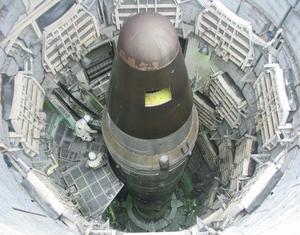Nuclear mattersU.S. has 5,113 strategic nuclear warheads -- down from 31,225 in 1967
IN 1967 The United States had 31,255 strategic nuclear warheads in its arsenal; in 1989, the number fell to 22,217; today, the number of warhead is 5,113; the number of non-strategic, or tactical, nuclear weapons fell by 90 percent between 1991 and 2009

One of 5,113 nuclear warheads // Source: hotindienews.com
The United States released newly declassified details about its nuclear stockpile today, including significant progress made in dismantling warheads. The United States had 5,113 warheads in its nuclear weapons stockpile as of 30 September, a senior defense official told reporters the other day.
This represents an 84 percent reduction from the end of fiscal 1967, when the U.S. nuclear arsenal was its largest, with 31,255 warheads, the official said. The current stockpile is 75 percent lower than when the Berlin Wall fell in late 1989, and the United States had 22,217 warheads.
American Forces Press Service’s Donna Miles writes that the United States is making continued progress in dismantling nuclear warheads: with 8,748 dismantled between fiscal years 1994 and 2009 and several thousand more currently retired and awaiting dismantlement, the official noted. Meanwhile, the number of non-strategic nuclear weapons in the U.S. arsenal dropped about 90 percent from 30 September 1991, to 30 September 2009.
“For those who doubt that the United States will do its part on disarmament, this is our record, these are our commitments,” Secretary of State Hillary Rodham Clinton told the UN conference on the Nuclear Proliferation Treaty in New York yesterday. “And they send a clear, unmistakable message.”
A senior defense official expressed hope that it would set a standard for the rest of the world, including China, to be more transparent about their nuclear weapons programs.
Clinton said the new Strategic Arms Reduction Treaty with Russia, once approved, will further limit the number of strategic nuclear weapons deployed by both countries to levels not seen since the 1950s.
Clinton also noted that the new Nuclear Posture Review, released in April, rules out the development of new U.S. nuclear weapons and new missions and capabilities for existing weapons. It also prohibits the use of nuclear weapons against non-nuclear weapons states that are parties to the NPT and comply with its nonproliferation obligations.
President Barack Obama has made reducing the threat posed by nuclear weapons and nuclear materials a central mission of U.S. foreign policy, Clinton told the conference. “I represent a president and a country committed to a vision of a world without nuclear weapons, and to taking the concrete steps necessary that will help us get there,” she said. “And, along with my delegation, I come to this conference with sincere and serous proposals to advance the fundamental aims of the NPT and strengthen the global nonproliferation regime.”
Although most nations live up to their nonproliferation responsibilities, Clinton said Iran’s nuclear weapons ambitions put the entire world at risk and urged the international community to hold it accountable. She called out Iranian president Mahmoud Ahmadinejad for spewing “the same tired, false and sometimes wild accusations” against the United States and other nations during his address to the assembly earlier today. “Iran will do whatever it can to divert attention away from its own record and … attempt to evade accountability,” she said.
Clinton urged Iran to join with other countries represented at the conference to “fulfill our international obligations and work toward the goal of a safer world.”
“When President Obama came into office, he recognized that the greatest potential danger facing the United States comes from a terrorist group like al Qaeda obtaining a crude nuclear device, not from a global nuclear war,” she said. “The threats of the 21st century cannot be addressed with a massive nuclear stockpile. So we are taking irreversible, transparent, verifiable steps to reduce the number of nuclear weapons in our arsenal.”
In the meantime, Clinton emphasized that the United States will not eliminate all its nuclear weapons until it is safe to do so. “The United States will maintain a nuclear deterrent for as long as nuclear weapons exist, one that can protect our country and our allies,” she said.
The U.S. nuclear stockpile includes both active and inactive warheads, defense officials explained. Active warheads include strategic and non-strategic weapons maintained in an operational, ready-for-use configuration, warheads that must be ready for possible deployment within a short timeframe, and logistics spares.
Inactive warheads are maintained in a non-operational status at depots, and have their tritium bottles removed.
